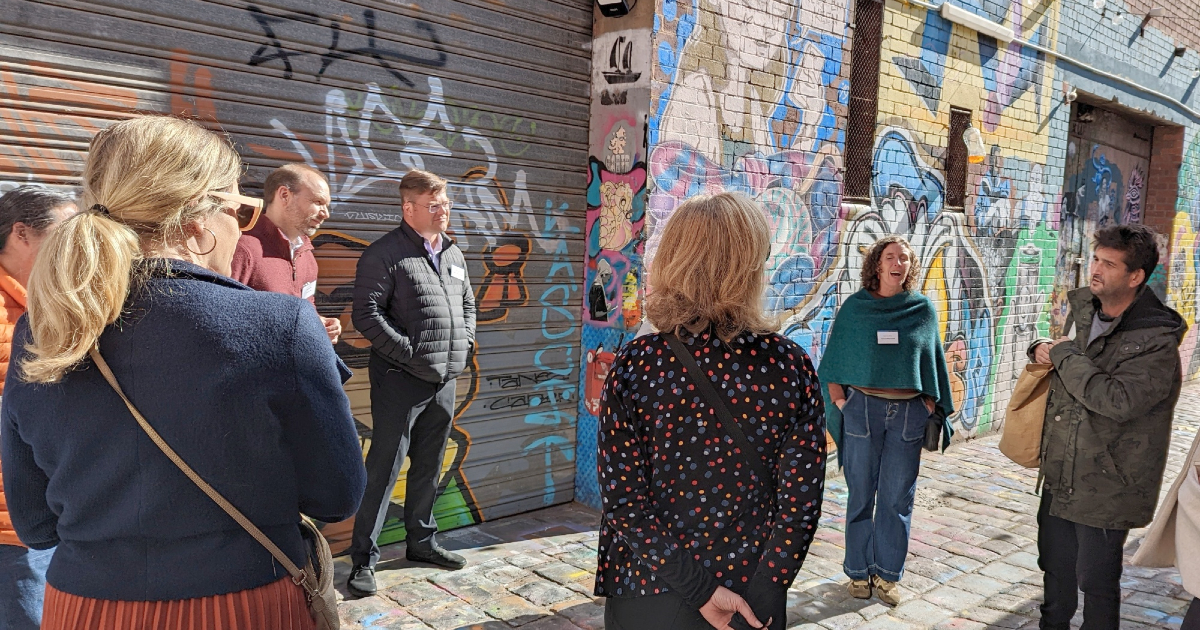Highlights of Smart Urban Futures 2022
20 May 2022
The eighth Smart Urban Futures conference was held on 5 and 6 May, as a hybrid online and in-person event for the first time.
With a significant investment in state-of-the-art conference technology, Victoria Walks and our conference partners the Municipal Association of Victoria (MAV) were able to provide a seamless, high-quality event for participants, whether they were at the venue or attending online.
When we asked people for their highlights from the conference we got a few responses like "so much to choose from that it's really difficult to pick highlights."
It certainly is tough to pick out just a few, but we've given it a try...
Ellie Cosgrave, Director of Publica in the UK, started the conference by inviting participants to channel Jane Jacobs – her willingness to challenge orthodoxy and bring her own experience to her work. As a feminist and civil engineer, Ellie’s insights on the city, planning and engineering through a gender lens provided a very thought-provoking start to the program.
Making the case for investment in walking and cycling was a key conference theme, and MAV chair David Clark started the conversation about funding. State governments need to step up with funding at a local level, not just for ‘mega projects’ that attract media attention.
Bec Mouy, Director of Streets and Centres at Transport for NSW, also talked about the importance of investment – “funding is a key enabler.” She gave examples from NSW’s $60 million investment in improving streets as shared spaces (separate to their impressive investment in walking and cycling for transport). Bec talked about the need for state governments to do more than get the regulatory framework right, they need to provide investment to drive change.
For a long time Sydney has looked to Melbourne, particularly the inner city, as the leader in better urbanism in Australia. But it does seem that Sydney is now leading the race. Other state governments need to understand their role in this space rather than leaving it all to local government.
Our own Ben Rossiter discussed Victoria Walks call out to councils for walking projects. The more than 300 projects submitted will form the basis of our advocacy for more government investment.
The optional lunch time walk explored street art and had an impromptu discussion with Adrian Doyle from Blender Studio (pictured above).
In a session on inclusive cities, Chris Edwards from Vision Australia gave us a perspective on the world from someone unable to use their eyes to see it. Chris talked about everything from dogs distracting his Seeing Eye Dog, to the impacts of technology and the need to keep footpaths clear of obstacles including overhanging branches - “footpaths are only clear when they’re clear to head height.” Lighting expert Hoa Yang pointed out that if we want a 24 hour city, we need people including women to feel safe travelling at night.
In a great session on climate change Matthew Baldwin, Deputy Director-General at the European Commission, told us “the deployment of zero emission vehicles will only provide part of the solution” to transport emissions. He compared it to “trying to play golf with one club,” with more walking, cycling and public transport also needed to address climate change. Matthew also talked about the incredible co-benefits of climate action that will offer a range of opportunities to build better communities in the future.
Helen Rowe from ClimateWorks pointed out that there were many reasons to re-orient transport away from private vehicles and that needs to be considered in the climate change conversation.
Helge Hillnhütter, Associate Professor at the Norwegian University of Science and Technology, started Day 2 with a fantastic presentation exploring the evidence on the psychology of walking and its relationship with public transport. He pointed out that almost half the time in a transit journey is on foot, but 70% of passenger’s memories or impressions of a public transport trip come from the walk. By making cities easier and more interesting to walk around, we can greatly expand the effective reach of public transport, as people will be willing to walk further to the stop.
Adele McCarthy, Chief Development Officer at Yarra Trams, talked about how streets with trams have a unique opportunity to be both high mobility streets, moving a lot of people, as well as great places. With Melbourne hosting the largest tram network in the world, this is an amazing opportunity for the city.
Professor of Transport Engineering David Levinson pointed out that walkers don’t get the benefit of co-ordinated traffic signals like motorists do. About 27% of the time spent on a walk that includes traffic lights at each intersection is waiting at lights.
So what did people think? Comments included:
“The best bits were practical new information that all attendees can apply to improve things right now.”
“Found all speakers had at least one thing I found relevant to my work or caused me to pause and reflect”
“Great to see the different departments and sectors involved: 20 mins, DoT, VW, local gov, MAV. Scene is set for more impactful collabs.”
“New research and data supporting the case for walking/cycling and demonstrating how it can be done - best practice”
“It was very interesting, informative, motivating and inspiring.”